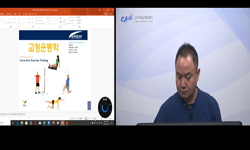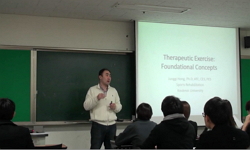Objective To investigate the effects of combination functional electrical stimulation (FES) and standing frame training on standing balance in stroke patients. Methods Patients who had hemiparesis and postural instability after stroke were randomly a...
http://chineseinput.net/에서 pinyin(병음)방식으로 중국어를 변환할 수 있습니다.
변환된 중국어를 복사하여 사용하시면 됩니다.
- 中文 을 입력하시려면 zhongwen을 입력하시고 space를누르시면됩니다.
- 北京 을 입력하시려면 beijing을 입력하시고 space를 누르시면 됩니다.
https://www.riss.kr/link?id=A106060754
-
저자
Joung Bok Lee (Dong-A University College of Medicine, Busan) ; Sang Beom Kim (Dong-A University College of Medicine, Busan) ; Kyeong Woo Lee (Dong-A University College of Medicine, Busan) ; Jong Hwa Lee (Dong-A University College of Medicine, Busan) ; Jin Gee Park (Dong-A University College of Medicine, Busan) ; Sook Joung Lee (Daejeon St. Mary's Hospital, College of Medicine, The Catholic University of Korea)

- 발행기관
- 학술지명
- 권호사항
-
발행연도
2019
-
작성언어
English
- 주제어
-
등재정보
KCI등재,SCOPUS
-
자료형태
학술저널
- 발행기관 URL
-
수록면
96-105(10쪽)
-
KCI 피인용횟수
0
- DOI식별코드
- 제공처
- 소장기관
-
0
상세조회 -
0
다운로드
부가정보
다국어 초록 (Multilingual Abstract)
Objective To investigate the effects of combination functional electrical stimulation (FES) and standing frame training on standing balance in stroke patients.
Methods Patients who had hemiparesis and postural instability after stroke were randomly assigned to one of the two groups; study group underwent FES on the quadriceps and tibialis anterior muscle simultaneously with standing balance training. The control group received standing frame training and FES separately. Both the groups received their respective therapies for 3 weeks. Stability index in Biodex Balance master system, Berg Balance Scale (BBS), manual muscle test, the Korean version of Modified Barthel Index, and Korean version of Mini- Mental State Examination were used to evaluate the effects of the treatment.
Results In total, 30 patients were recruited to the study group and 30 to the control group. Three weeks after treatment, both the groups showed improvement in postural stability scores and physical and cognitive functions.
When changes in postural stability were compared between the groups, the study group showed more significant improvement than the control group with regards to the scores of BBS and the stability indices.
Conclusion In this study, we found the therapeutic effectiveness of combined therapy of FES and standing frame in subacute stroke patients. The presented protocol is proposed as time-saving and can be applied easily in the clinical setting. Thus, the proposed combined therapy could be a useful method for improving standing balance in subacute stroke patients.
참고문헌 (Reference)
1 Grainger KP, "‘Things aren’t the same, are they?’ : the management of bad news delivery in the discourse of stroke care" 2 : 35-44, 2005
2 Nadeau SM, "Weightbearing perception during standing and sit-to-stand tasks in subacute post-stroke individuals undergoing intensive rehabilitation" 59 (59): e71-e72, 2016
3 Messier S, "Weightbearing on the lower limbs in a sitting position during bilateral movement of the upper limbs in post-stroke hemiparetic subjects" 37 : 242-246, 2005
4 Blum L, "Usefulness of the Berg Balance Scale in stroke rehabilitation : a systematic review" 88 : 559-566, 2008
5 Hokstad A, "Upright activity within the first week after stroke is associated with better functional outcome and health-related quality of life : a Norwegian multi-site study" 48 : 280-286, 2016
6 Cabanas-Valdes R, "The effect of additional core stability exercises on improving dynamic sitting balance and trunk control for subacute stroke patients : a randomized controlled trial" 30 : 1024-1033, 2016
7 Aze O, "Structural and physiological muscle changes after post-stroke hemiplegia: a systematic review" 59 (59): e79-, 2016
8 Matjacic Z, "Sit-to-stand trainer : an apparatus for training"normal-like"sit to stand movement" 24 : 639-649, 2016
9 Palmer JA, "Single session of functional electrical stimulationassisted walking produces corticomotor symmetry changes related to changes in poststroke walking mechanics" 97 : 550-560, 2017
10 Zhang D, "Simulation study of FES-assisted standing up with neural network control" 7 : 4877-4880, 2004
1 Grainger KP, "‘Things aren’t the same, are they?’ : the management of bad news delivery in the discourse of stroke care" 2 : 35-44, 2005
2 Nadeau SM, "Weightbearing perception during standing and sit-to-stand tasks in subacute post-stroke individuals undergoing intensive rehabilitation" 59 (59): e71-e72, 2016
3 Messier S, "Weightbearing on the lower limbs in a sitting position during bilateral movement of the upper limbs in post-stroke hemiparetic subjects" 37 : 242-246, 2005
4 Blum L, "Usefulness of the Berg Balance Scale in stroke rehabilitation : a systematic review" 88 : 559-566, 2008
5 Hokstad A, "Upright activity within the first week after stroke is associated with better functional outcome and health-related quality of life : a Norwegian multi-site study" 48 : 280-286, 2016
6 Cabanas-Valdes R, "The effect of additional core stability exercises on improving dynamic sitting balance and trunk control for subacute stroke patients : a randomized controlled trial" 30 : 1024-1033, 2016
7 Aze O, "Structural and physiological muscle changes after post-stroke hemiplegia: a systematic review" 59 (59): e79-, 2016
8 Matjacic Z, "Sit-to-stand trainer : an apparatus for training"normal-like"sit to stand movement" 24 : 639-649, 2016
9 Palmer JA, "Single session of functional electrical stimulationassisted walking produces corticomotor symmetry changes related to changes in poststroke walking mechanics" 97 : 550-560, 2017
10 Zhang D, "Simulation study of FES-assisted standing up with neural network control" 7 : 4877-4880, 2004
11 Mohapatra S, "Role of contralesional hemisphere in paretic arm reaching in patients with severe arm paresis due to stroke : a preliminary report" 617 : 52-58, 2016
12 Kim K, "Repetitive sit-to-stand training with the step-foot position on the non-paretic side, and its effects on the balance and foot pressure of chronic stroke subjects" 27 : 2621-2624, 2015
13 de Haart M, "Recovery of standing balance in postacute stroke patients : a rehabilitation cohort study" 85 : 886-895, 2004
14 Raja B, "Quantifiable patterns of limb loading and unloading during hemiparetic gait : Relation to kinetic and kinematic parameters" 49 : 1293-1304, 2012
15 Khaslavskaia S, "Motor cortex excitability following repetitive electrical stimulation of the common peroneal nerve depends on the voluntary drive" 162 : 497-502, 2005
16 Montastruc J, "Main determinants of weight-bearing asymmetry in hemiplegic stroke patients" 59 (59): e69-, 2016
17 van Bloemendaal M, "Gait training assisted by multichannel functional electrical stimulation early after stroke : study protocol for a randomized controlled trial" 17 : 477-, 2016
18 Beyaert C, "Gait post-stroke : pathophysiology and rehabilitation strategies" 45 : 335-355, 2015
19 Chen D, "Functional electrical stimulation based on a working pattern influences function of lower extremity in subjects with early stroke and effects on diffusion tensor imaging : a randomized controlled trial" 94 : 2886-2892, 2014
20 Bishop L, "Exploration of two training paradigms using forced induced weight shifting with the tethered pelvic assist device to reduce asymmetry in individuals after stroke: case reports" 96 (96): S135-S140, 2017
21 Malesevic J, "Evolution of surface motor activation zones in hemiplegic patients during 20 sessions of FES therapy with multi-pad electrodes" 26 : 6059-, 2016
22 Hugues A, "Efficiency of physical therapy on postural imbalance after stroke : study protocol for a systematic review and meta-analysis" 7 : e013348-, 2017
23 Liu M, "Effects of modified sit-to-stand training on balance control in hemiplegic stroke patients : a randomized controlled trial" 30 : 627-636, 2016
24 Gervasoni E, "Effects of functional electrical stimulation on reducing falls and improving gait parameters in multiple sclerosis and stroke" 9 : 339-347, 2017
25 Tan ZM, "Effects of functional electrical stimulation based on normal gait pattern on walking function in subjects with recovery of stroke" 96 : 2342-2346, 2016
26 Braun T, "Effects of additional, dynamic supported standing practice on functional recovery in patients with sub-acute stroke : a randomized pilot and feasibility trial" 30 : 374-382, 2016
27 Bustamante C, "Effect of functional electrical stimulation on the proprioception, motor function of the paretic upper limb, and patient quality of life : a case report" 29 : 507-514, 2016
28 Haruyama K, "Effect of core stability training on trunk function, standing balance, and mobility in stroke patients" 31 : 240-249, 2017
29 Chen HX, "Effect of comprehensive protocol of integrative medicine on motor function, activity of daily living and quality of life in hemiplegia patients after stroke" 36 : 395-398, 2016
30 Maeda N, "Discriminant analysis for predictor of falls in stroke patients by using the Berg Balance Scale" 56 : 280-283, 2015
31 Vistamehr A, "Correlations between measures of dynamic balance in individuals with post-stroke hemiparesis" 49 : 396-400, 2016
32 Palm HG, "Computerized dynamic posturography : the influence of platform stability on postural control" 93 : 49-55, 2014
33 Thibaut A, "Brain plasticity after implanted peroneal nerve electrical stimulation to improve gait in chronic stroke patients : Two case reports" 40 : 251-258, 2017
34 De Nunzio A, "Biofeedback rehabilitation of posture and weightbearing distribution in stroke : a center of foot pressure analysis" 29 : 127-134, 2014
35 Geurts AC, "A review of standing balance recovery from stroke" 22 : 267-281, 2005
36 Bagley P, "A randomized trial evaluation of the Oswestry Standing Frame for patients after stroke" 19 : 354-364, 2005
37 Hendrie WA, "A pilot mixed methods investigation of the use of Oswestry Standing Frames in the homes of nine people with severe multiple sclerosis" 37 : 1178-1185, 2015
38 Ferrante S, "A personalized multi-channel FES controller based on muscle synergies to support gait rehabilitation after stroke" 10 : 425-, 2016
동일학술지(권/호) 다른 논문
-
- 대한재활의학회
- Kyeong Woo Lee
- 2019
- KCI등재,SCOPUS
-
- 대한재활의학회
- Sae Hoon Chung
- 2019
- KCI등재,SCOPUS
-
- 대한재활의학회
- Young-Cheol Yun
- 2019
- KCI등재,SCOPUS
-
Characteristics and Clinical Course of Dysphagia Caused by Anterior Cervical Osteophyte
- 대한재활의학회
- 최희은
- 2019
- KCI등재,SCOPUS
분석정보
인용정보 인용지수 설명보기
학술지 이력
| 연월일 | 이력구분 | 이력상세 | 등재구분 |
|---|---|---|---|
| 2023 | 평가예정 | 해외DB학술지평가 신청대상 (해외등재 학술지 평가) | |
| 2020-01-01 | 평가 | 등재학술지 유지 (해외등재 학술지 평가) |  |
| 2011-06-28 | 학술지명변경 | 한글명 : 대한재활의학회지 -> Annals of Rehabilitation Medicine |  |
| 2011-01-01 | 평가 | 등재학술지 유지 (등재유지) |  |
| 2009-01-01 | 평가 | 등재학술지 유지 (등재유지) |  |
| 2007-01-01 | 평가 | 등재학술지 유지 (등재유지) |  |
| 2005-01-01 | 평가 | 등재학술지 유지 (등재유지) |  |
| 2002-07-01 | 평가 | 등재학술지 선정 (등재후보2차) |  |
| 2000-01-01 | 평가 | 등재후보학술지 선정 (신규평가) |  |
학술지 인용정보
| 기준연도 | WOS-KCI 통합IF(2년) | KCIF(2년) | KCIF(3년) |
|---|---|---|---|
| 2016 | 0.19 | 0.19 | 0.17 |
| KCIF(4년) | KCIF(5년) | 중심성지수(3년) | 즉시성지수 |
| 0.19 | 0.19 | 0.397 | 0.01 |





 KCI
KCI







